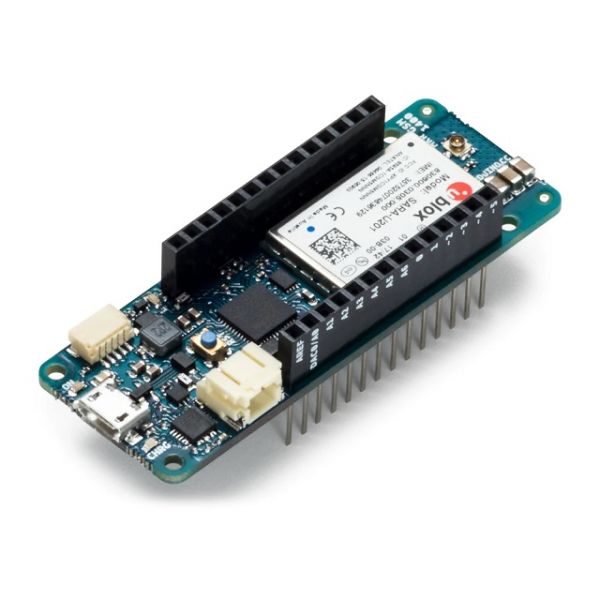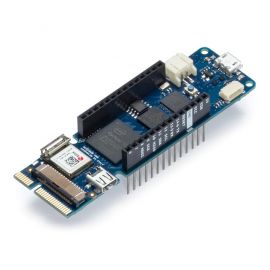Arduino: MKR GSM 1400 with Arm Cortex-M0 32-bit SAMD21, u-blox SARA-U201 - MKRGSM1400WANT
Here you will find the technical specifications for the Arduino MKR GSM 1400.
Please read: operating voltage is 3.3V
The microcontroller on the this board runs at 3.3V, which means that you must never apply more than 3.3V to its Digital and Analog pins. Care must be taken when connecting sensors and actuators to assure that this limit of 3.3V is never exceeded. Connecting higher voltage signals, like the 5V commonly used with the other Arduino boards, will damage the board.
Please read: black conductive foam
You should remove the black conductive foam from the board pins before usage. If you don't remove it, the board may behave erratically.
| Board | Name | Arduino® MKR GSM 1400 |
|---|---|---|
| SKU | ABX00018 | |
| Compatibility | MKR | |
| Microcontroller | SAMD21 Cortex®-M0+ 32bit low power ARM MCU | |
| USB connector | Micro USB | |
| Pins | Built-in LED Pin | 6 |
| Digital I/O Pins | 8 | |
| Analog Input Pins | 7 (ADC 8/10/12 bit) | |
| Analog Output Pins | 1 (DAC 10 bit) | |
| PMW Pins | 13 (0 - 8, 10, 12, A3, A4) | |
| External interrupts | 10 (0, 1, 4, 5, 6, 7, 8 ,9, A1, A2) | |
| Connectivity | GSM / 3G | u-blox SARA-U201 |
| SIM Card | MicroSIM (not included with the board) | |
| Working region | Global | |
| Data Rate (LTE M1 Half-Duplex) | UL 375 kbps / DL 300 kbps | |
| Data Rate (LTE NB1 Full-Duplex) | UL 62.5 kbps / DL 27.2 kbps | |
| Secure element | ATECC508A | |
| Carrier frequency | GSM | 850 MHz |
| E-GSM | 1900 MHz | |
| DCS | 1800 MHz | |
| PCS | 1900 MHz | |
| Communication | UART | Yes |
| I2C | Yes | |
| SPI | Yes | |
| Power | I/O Voltage | 3.3V |
| Input Voltage (nominal) | 5-7V | |
| DC Current per I/O pin | 7 mA | |
| Supported battery | Li-Po Single Cell, 3.7V, 2500mAh Minimum | |
| Battery connector | JST PH | |
| Clock speed | Processor | 48 MHz |
| RTC | 32.768 kHz | |
| Memory | SAMD21G18A | 256KB Flash, 32KB SRAM |
| Dimensions | Weight | 32 g |
| Width | 25 mm | |
| Length | 67.6 mm | |
Arduino MKR GSM 1400 allows you to build your next smart project. Ever wanted an automated house? Or a smart garden? Well, now it’s easy with the Arduino IoT Cloud compatible boards. It means: you can connect devices, visualize data, control and share your projects from anywhere in the world. Whether you’re a beginner or a pro, we have a wide range of plans to make sure you get the features you need.
The Arduino MKR GSM 1400 takes advantage of the cellular network as a means to communicate. The GSM / 3G network is the one that covers the highes percentage of the world's surface, making this connectivity option very attractive when no other connectivity options exist. Whether you are looking at building a gateway to your own remote sensor network, or if you need a single device sending a text message when an event happens at the other side of the country, the MKR GSM 1400 will help you to quickly implement a solution to accommodate your needs.
The board's main processor is a low power Arm® Cortex®-M0 32-bit SAMD21, like in the other boards within the Arduino MKR family. The GSM / 3G connectivity is performed with a module from u-blox, the SARA-U201, a low power chipset operating in the de different bands of the cellular range (GSM 850 MHz, E-GSM 1900 MHz, DCS 1800 MHz, PCS 1900 MHz). On top of those, secure communication is ensured through the Microchip® ECC508 crypto chip. Besides that, you can find a battery charger, and a connector for an external antenna.
GSM and Arduino IoT Cloud
At Arduino we have made connecting to a GSM network as easy as getting an LED to blink. You can set or receive calls, send and receive text messages, and access data networks to exchange data with different types of servers. You can even create your own server operating on the GPRS data network! The specific set of examples we provide for the MKR GSM 1400 can be consulted at the MKRGSM library reference page.
It is also possible to connect your board to different Cloud services, Arduino's own among others. Here some examples on how to get the MKR GSM 1400 to connect to:
- Arduino's own IoT Cloud: Arduino's IoT Cloud is a simple and fast way to ensure secure communication for all of your connected Things. Check it out here
- Blynk: a simple project from our community connecting to Blynk to operate your board from a phone to remote control two different relays
- Google IoT Cloud: here an example of sending data to Google's IoT Cloud using MQTT and JSON
- SORACOM Air IoT: a specific case using SORACOM's platform on how to connect to send and graph data from a temperature sensor
- GSM Location + Google Maps: the following example shows how to localize your board by sending an SMS that will obtain the board's location from the GSM infrastructure
- Google Spreadsheets via Arduino IoT Cloud: collect data from an industrial sensor, send it over the Arduino IoT Cloud via cellular network and from there to a GSheet using webhooks, this example will show you how to do it
Ensuring Connectivity
The default option for the MKR GSM 1400 does NOT include a SIM card, you can hook up the board to any operator of your choice. However, if you are interested in a world-wide coverage option for your solution, at Arduino we have created the Arduino SIM - MKR GSM bundle. The package which includes the exclusive Arduino SIM card will get your board online from (almost) anywhere in the world and connect to the Arduino IoT Cloud (only). It is also possible to purchase the SIM card separately.
The Arduino SIM sends data only to the Arduino IoT Cloud. In this way, we provide you with a secure communication channel from device to dashboard. Once data reaches the Arduino IoT Cloud, it is possible to bridge it to other platforms and services via webhooks or the Arduino IoT API.
Battery Power
Its USB port can be used to supply power (5V) to the board. It has a Li-Po charging circuit that allows the board to run on battery power or an external 5 volt source, charging the Li-Po battery while running on external power. Switching from one source to the other is done automatically.
Communication over cellular networks, requires current peaks above the maximum a USB port can provide. While the port reaches 500mA, a typical GSM handshake (when the board boots and registers on a network provider) could easily reach a 2A peak. Therefore it is recommended to either provide a source with a higher current limit over Vin, or having a LiPo battery of, at least, 2500 mAh.
Related Boards
If you are still deciding about the right wireless protocol for your solution, Arduino's MKR family has some alternatives to offer:
- MKR FOX 1200: for your EU solutions on Sigfox infrastructure. Visit its product page here.
- MKR WAN 1310: if you want to experiment with either LoRa® or LoRaWAN™. Read more here. We have also a LoRa® gateway if you are thiking of building your own infrastructure.
- MKR NB 1500: if your solution is designed around Narrowband IoT. Read more about it here.
| Part Number | MKRGSM1400WANT |
|---|---|
| Manufacturer | Arduino |
| Weight (KG) | 0.030000 |
| Packing Unit | 1 Piece |
| Product Availability | In Stock |





Log In